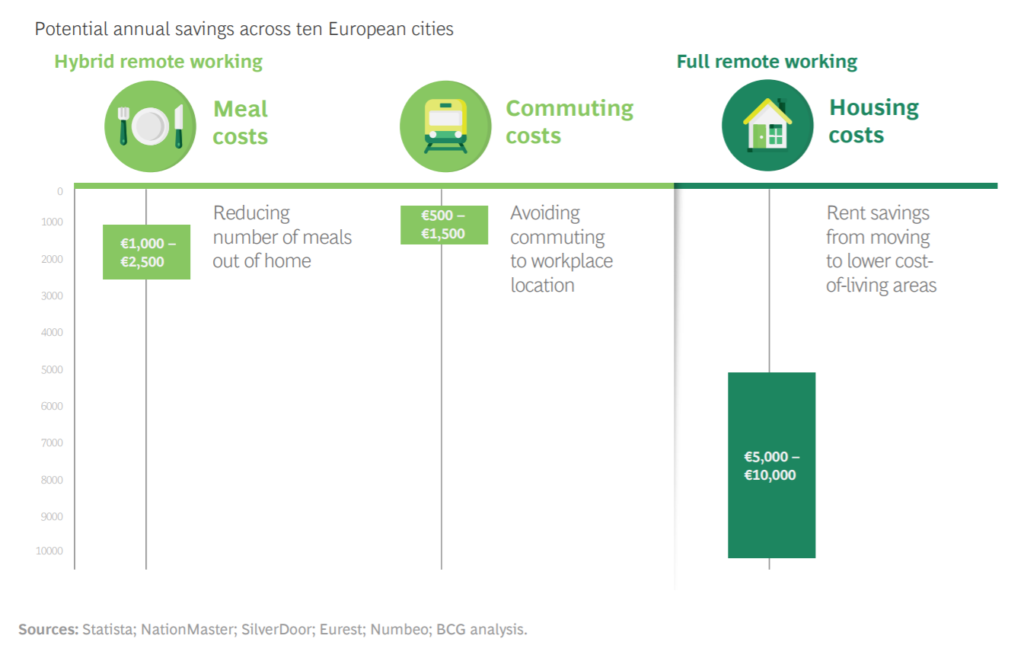Remote work has become increasingly popular in recent years, especially for freelancers and entrepreneurs. It offers many advantages over traditional office jobs, but there are also some drawbacks that need to be considered before making the switch. So, let’s delve deeper into the topic and talk about benefits and challenges of remote working so that you could decide whether it’s your cup of tea.
Benefits of remote work
Many leaders, especially those who have a micromanaging leadership style, are wary of remote working. The reasons are obvious – lack of trust in employees, too much freedom that can cause complacence from the staff and difficulty supervising every stage of the work they do.
However, these fears are often unfounded and can be lifted by careful selection of the people you work with. In the end, if you don’t trust someone, why would you hire them in the first place?
Moreover, the benefits of remote work prove to outweigh potential risks. In fact, researchers have found that remote workers are often more productive than their office counterparts.
According do the research conducted by Boston Consulting Group, almost all remote employees recognized at least one benefit of remote working.
Let’s have a look at some of them.
1. Work + personal life
One of the pros of working from home means not missing out on your kids growing up, having lunch with your family or being there for your loved ones when they’re sick. Even if you need to run some errands during your working hours you have the ability to make up for it at a more convenient time. The ability to have a fulfilling personal life increases individual’s overall happiness which makes positive impact on their productivity and job satisfaction.

2. Flexible schedule
Everyone has their own biological clock and their periods of high and low productivity. The 9-6pm working schedule doesn’t suit every person. Some of us like to wake up at 5am and get to work as early as possible, and others prefer to sleep till noon and feel energetically charged only in the evenings or at night.

©2020 Microsoft Corporation
Of course, there are certain meetings to attend where everyone should be present, but beyond team meetings and discussions, having the liberty to do your job at your own time positively impacts your health and drives great results at work.

3. Fewer distractions
One might disagree with this point, but there’s a big difference between distractions that you may face when work from the office, and when you do remote working.
At home, often you choose your own distractions – whether it’s to spend some time with your kids, walk a dog or simply check out social media posts.
In the office, however, you can be constantly disturbed by your colleagues, manager, or never-ending meetings. When were you able to work 2 hours straight without any distractions in the office? You can do it, though, when you work remotely.
4. Less time wasted on meaningless meetings
This benefit derives right from the one mentioned above. Studies show that executives spend about half of their working time in meetings. However, one doesn’t have to be an executive to feel like they’re drowning in meaningless meetings.
The beauty of remote work is that you have much more time to focus on your direct responsibilities and get the job done much faster.
5. No commutes
Many people spend hours getting to their office. In fact, researchers say that WFH employees save an average of 75 hours per year in avoided commute time.
This time can be saved on a better sleep or other activities that improve your employee’s wellbeing: having breakfast with their loved ones, exercising, meditation, etc. One cannot overestimate the positive impact that these activities have on our mood and productivity.

6. Fewer absences
Since your employees are working remotely, they won’t take as many sick leaves, if any. If their condition isn’t serious, they can just as well perform their duties remotely without the risk of infecting co-workers.
And the truth is, many of us ask for a sick day when in fact we have to deal with a personal matter. With remote work the problem resolves itself, meaning less absences and fewer losses for the firm.
7. Cost reduction
Having a remote team can actually save you money. And not only on furniture, computer equipment, stationary, and snacks – although that too eats up a decent amount off your budget. You are also saving money on real estate, not having to rent a bigger place for all of your staff.
Additionally, you will spend much less, if at all, on travel and accommodation costs for business trips.
Your employees will find remote working more cost-efficient, too. Below is the data from the research conducted by BCG experts.

©Boston Consulting Group
8. Improved collaboration
Everyone is now used to having video meetings, and there’s very few topics that you could not discuss over a call. Especially now that Microsoft Teams has strong security capabilities, business figures feel more free to discuss private matters over a virtual meeting.
Due to the necessity to communicate virtually with both internal and external stakeholders, collaboration greatly improves as geography and logistics are no longer an issue. This means that with the use of the right technology decisions can be made much faster and the deal cycle can shorten due to accelerated collaboration.

9. Expands talent pool
Remote work allows you to access the talent pool that you wouldn’t consider for the office work for various reasons. Young parents, seniors, disabled people, part-time workers, students, as well as talents located in a different country can be your potential employees. This opens vast opportunities for increasing the quality of your staff.

10. Empowers workers
Having the opportunity to organize work, prioritize tasks and be responsible for one’s own contribution to the organization empowers workers. Being independent lets them show initiative and as a result enhances the performance of the whole company by bringing innovative ideas and solutions.
Additionally, when you give the opportunity to individuals from diversified backgrounds, you encourage diversity, tolerance and cultural exchange that promotes a healthy culture in your company.
The list is not exhaustive, and chances are you can add a few more points based on our own experience. This only confirms the fact that remote work can be beneficial for both the organization and its employees.
Challenges of remote work
However, we do have to take remote work with a pinch of salt. There are certain downsides to it that have to be addressed by the organizations and the staff in order to ensure effective performance.
Here are some of the most common issues related to WFH (working from home):
1. Onboarding
It’s not the same – going to the office, shadowing your supervisor, familiarizing yourself with new responsibilities by consulting your colleagues and, on the other hand, being on you own with your laptop trying to figure out what to do and how to do it right.

There’s a reason why a lot of us prefer physical onboarding. It’s a lot less stressful and, as a famous proverb says, it’s better to see something once, than to hear about it a thousand times. That’s what makes online onboarding trickier.
However, it doesn’t mean that you can’t make it more efficient. With the right tools and practices you can ensure your employees feel welcomed and get a grip on their responsibilities in no time.
2. Miscommunication or lack of communication
Another common challenge of remote working. Not being able to see the person you’re talking to can cause misunderstanding. Additionally, you don’t always get an instant reply from a person you’re reaching out to, which slows down your work.
Establishing certain rules for communication that correspond to you company’s working culture is the way to go for addressing this challenge.
3. Coordination of work among team members
Teamwork is an essential part of our working lives. Some people spend over 50% of their working time collaborating with others. Coordinating responsibilities becomes vital for the team’s success and doing so remotely can become an issue.
In order to overcome it, teams need to establish a clear structure of their projects and distribute tasks accordingly. This way everyone will know how to contribute to the project’s success.
To do so, organizations need to adopt the right digital tools that would help their employees organize teamwork.
4. Low productivity
We talked about the fact that remote working increases productivity as it allows you to avoid many office-related distractions. However, there’s a downside to working from home as well. Some people find it hard to switch from a couch potato mode to an office worker.

We’ve all felt it. Having to work from your own bed or at the kitchen table doesn’t put you in the right mood. Your brain is used to the fact that these are not places where you think of work, so it can take quite a bit of time to adjust to new realities.
This especially concerns people who do not have a dedicated work/study area in the place where they live.
Organizing well your workspaces, taking mindful breaks, and having clear objectives for each working day and having a productive conversation with the colleagues can help you fight lethargy.
5. Overcompensating/sticking to old office practices
Because we are not present at the office and cannot face are colleagues, we sometimes try to compensate it by organizing many meetings which are not always necessary.
The challenge here is that it distracts us from our direct responsibilities and causes low productivity.
However, we can address this issue by creating a company’s remote working culture. It should be focused on encouraging individual work, letting employees work in their own environment without the need to make up for the lack of physical presence.
The beauty of remote working is that you can concentrate on your work for a long time without being disturbed by others. So, keep all the meetings short, concise and straight to the point.
6. Less creativity
As someone famous said, alone we can do so little, together we can do so much. It holds true for creativity as it is fueled by knowledge and team spirit. Sometimes we can come up with the best ideas just because we were inspired by something our colleague said, even if it’s not relevant to the topic of the discussion.
We need teamwork and collective brainstorming to think of innovative solutions. But how do arrange it if you work remotely?
The truth is you don’t have to miss out on collective creativity session just because your team works from home. These days there are various solutions that create the environment necessary for brainstorming and discussions.
7. Lack of social interactions
Social interaction is one of the basic human needs. And you don’t even have to be friends with everyone in the office: just the ability to chit-chat with someone while you’re pouring coffee can be enough to lift up your mood a little bit.
Therefore, some people might miss out on these interactions and lose the sense of belonging to the team – something that many companies try to establish and nourish by organizing various teambuilding events. The feeling of belonging is vital for our wellbeing. Knowing that you are a part of a community is one of our basic needs and working remotely kind of deprives us of that.
And it is particularly important to address this issue if you want to have a happy team. Warm and healthy relationships within a team stimulates everyone’s productivity, wellbeing, and job satisfaction. It is recommended, therefore, to make up for the lack of social interactions in the office with other types of activities.
8. Work-life balance
Another problem with working from home is the sense that you never actually stop working. Everyone is working in their own rhythm and you feel like you need to reply right away, even if your colleague sent a message on a Saturday night.
Being able to ‘switch’ can be a challenge as sometimes you don’t feel when the work ends, and your personal life begins.
Finding a way to maintain work-life balance becomes key to maintaining well-being and avoiding burnouts. Luckily, Microsoft Teams has already come up with different solutions that will help you keep the right work rhythm without interrupting your personal life.

9. Bringing personal life to work
How many times did you hear your colleague’s kids screaming, or your boss’s dog barking, or felt embarrassed by your own boyfriend passing shirtless in front of the camera? We’ve all been there.
It can be distracting both for you and your colleagues and leaving your personal life out of the scope of your work becomes a challenge.
But technology doesn’t stand still and there’s a solution even for that.

Final verdict
While there are plenty of pros and cons to consider, the downsides don’t outweigh all the benefits of remote working. In fact, most of them can be resolved. If you are not ready to switch to full remote working, you can opt to have hybrid work practices, that will combine the benefits of both remote and office work.
We at SalesTim are convinced that choosing the right digital tool for collaboration and communication such as Microsoft Teams, as well as building a positive remote work culture are essential to succeed in remote working. It can help your staff stay connected with each other, improve communication, feel motivated to do their best and enjoy being a part of your team.
Not sure where to start? Check out our series of articles about Microsoft Teams Adoption. And don’t miss our next article on how to build a healthy remote working culture that will help you reevaluate and address all the pros and cons of remote working.
